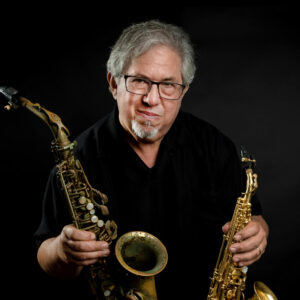Of Light and Solace
André Lamproye composer
Guy de Lioncourt composer
Wilmer Welsh composer
Chris DeBlasio composer
David Sampson composer
Calvin Hampton composer
Paul Cohen Conn-O-Sax & soprano saxophone
Andrew Henderson organ
Paul Cohen’s OF LIGHT AND SOLACE highlights music by several 20th century composers whose work is deeply engaged with both the tradition and innovation of classical music. Evocative, contemplative, and teeming with emotional depth, the works presented in this Ravello Records release explore and expand upon the liturgical canon, offering instrumental expressions in Gregorian Chant, fresh takes on the iconic Amazing Grace, and more. Cohen pairs a unique selection of saxophones with organ to bring this music to life including his Conn-O-Sax, a bold, innovative saxophone made by the Conn Company for a very limited time in 1928.
Listen
Stream/Buy
Choose your platform
Track Listing & Credits
| # | Title | Composer | Performer | |
|---|---|---|---|---|
| 01 | Hommage à St. Hadelin (1988): Entrée Solennelle | André Lamproye | Paul Cohen, soprano saxophone; Andrew Henderson, organ | 6:11 |
| 02 | Hommage à St. Hadelin (1988): Meditation | André Lamproye | Paul Cohen, soprano saxophone; Andrew Henderson, organ | 3:19 |
| 03 | Hommage à St. Hadelin (1988): Sortie-Final | André Lamproye | Paul Cohen, soprano saxophone; Andrew Henderson, organ | 3:23 |
| 04 | Trois Mélodies Grégoriennes (1924): Clemens Rector | Guy de Lioncourt | Paul Cohen, Conn-O-Sax; Andrew Henderson, organ | 2:31 |
| 05 | Trois Mélodies Grégoriennes (1924): Puer natus est | Guy de Lioncourt | Paul Cohen, Conn-O-Sax; Andrew Henderson, organ | 1:49 |
| 06 | Trois Mélodies Grégoriennes (1924): Pascha nostrum | Guy de Lioncourt | Paul Cohen, Conn-O-Sax; Andrew Henderson, organ | 2:07 |
| 07 | Liturgical Music (1986): Introit | Wilmer Hayden Welsh | Paul Cohen, soprano saxophone; Andrew Henderson, organ | 2:26 |
| 08 | Liturgical Music (1986): Kyrie | Wilmer Hayden Welsh | Paul Cohen, soprano saxophone; Andrew Henderson, organ | 2:11 |
| 09 | Liturgical Music (1986): Agnus Dei | Wilmer Hayden Welsh | Paul Cohen, soprano saxophone; Andrew Henderson, organ | 2:16 |
| 10 | Liturgical Music (1986): Gloria | Wilmer Hayden Welsh | Paul Cohen, soprano saxophone; Andrew Henderson, organ | 3:44 |
| 11 | Music for a Short Subject | Chris DeBlasio | Paul Cohen, soprano saxophone; Andrew Henderson, organ | 7:45 |
| 12 | Tenebrae (2000) | David Sampson | Paul Cohen, Conn-O-Sax; Andrew Henderson, organ | 6:48 |
| 13 | Variations on Amazing Grace (1983) | Calvin Hampton | Paul Cohen, Conn-O-Sax; Andrew Henderson, organ | 13:22 |
Recorded August 2023 at Madison Avenue Presbyterian Church in New York City NY
Recording Session Producer & Engineer Richard Price
Mastering Richard Price
Executive Producer Bob Lord
A&R Director Brandon MacNeil
A&R Jeff LeRoy
VP of Production Jan Košulič
Audio Director Lucas Paquette
VP, Design & Marketing Brett Picknell
Art Director Ryan Harrison
Design Morgan Hauber
Publicity Chelsea Kornago
Digital Marketing Manager Brett Iannucci
Artist Information

Paul Cohen
Paul Cohen is a sought-after saxophonist for orchestral and chamber concerts and solo recitals. He has appeared as soloist with the San Francisco Symphony, Richmond Symphony, New Jersey Symphony, Charleston Symphony, and the Philharmonia Virtuosi. His many solo orchestra performances include works by Debussy, Creston, Ibert, Glazunov, Martin, Loeffler, Husa, Dahl, Still, Villa-Lobos, Tomasi, and Cowell. He has also performed with a broad range of orchestras, including the New York Philharmonic, Metropolitan Opera (NYC), American Symphony Orchestra, Cleveland Orchestra, Santa Fe Opera, New Jersey Symphony, Oregon Symphony, San Diego Symphony, Long Island Philharmonic, Group for Contemporary Music, Greenwich Symphony, and New York Solisti.

Andrew Henderson
Andrew Henderson has served as Director of Music & Organist at Madison Avenue Presbyterian Church in New York City since 2005, where he oversees an extensive liturgical and choral program, including the Saint Andrew Chorale and the Saint Andrew Music Society’s Music on Madison concert series. He also serves on the organ faculty of the Manhattan School of Music, as organ instructor at Teachers College, Columbia University, as Associate Organist at New York City’s Temple Emanu-El, and as the Executive Director and principal accompanist of the New York City Children’s Chorus.




